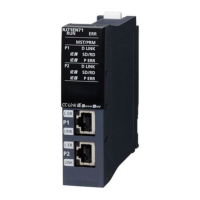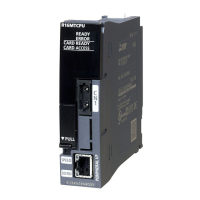216
10 TROUBLESHOOTING
10.4 Troubleshooting by Symptom
When a station is disconnected from the network
The following is the action to be taken when a station in data link is disconnected.
If the above action does not solve the problem, perform the module communication test to check for hardware failure. (
Page 200 Module communication test)
When a station is repeatedly disconnected and reconnected
The following lists the actions to be taken when a station in data link is repeatedly disconnected and reconnected.
Check item Action
Is the ambient temperature for the module outside the specified range? Keep the ambient temperature within the specified range by taking action
such as removing heat source.
Check item Action
Do the used Ethernet cables conform to the Ethernet standard? If not, replace them with Ethernet cables that satisfy the Ethernet standard.
( Page 128 Ethernet cable)
Is the station-to-station distance 100m or less? Change the station-to-station distance to 100m or less.
Does the cabling condition (bending radius) meet the specifications? Refer to the manual for the Ethernet cable, and if the bending radius
exceeds the specified range, correct the bending radius.
Is any Ethernet cable disconnected? If an Ethernet cable is disconnected, replace the Ethernet cable.
Is the industrial switch used in the system operating normally? • Check that an industrial switch that conforms to the standard is used.
( Page 128 Industrial switch)
• Power off and on the industrial switch.
Is the time synchronization source station operating normally? Take action by referring to the manual for the module of the time
synchronization source station.
Are resets of other stations repeated? Avoid unnecessary reset since a station is disconnected while resetting.
Are other stations repeatedly powering on/off? Avoid unnecessary power-off, since a station is disconnected while turned
off.
When "Communication Speed" of the master station is set to "100Mbps", is
"Basic Settings" "Communication Period Setting" "Basic Period Setting"
"System Reservation Time" of the master station set to 20s?
Set "System Reservation Time" to 200s.
When the communication speed of the master station is set to 1Gbps and a CC-
Link IE TSN Class B/A device with a communication speed of 100Mbps is used,
is "Communication Period Setting" set to "Basic Period" or "Normal-Speed"?
For a CC-Link IE TSN Class B/A device with a communication speed of
100Mbps, set "Communication Period Setting" to "Low-Speed".
For firmware version "1.010" or later
When the communication speed of the master station is set to 1Gbps and a CC-
Link IE TSN Class B/A device with a communication speed of 100Mbps is used
in multicast mode, is the station disconnected and returned repeatedly even if
"Communication Period Setting" is set to "Low-Speed"?
For firmware version "1.002" or earlier
When the communication speed of the master station is set to 1Gbps and a CC-
Link IE TSN Class B/A device with a communication speed of 100Mbps is used,
is the station disconnected and returned repeatedly even if "Communication
Period Setting is set to "Low-Speed"?
For firmware version "1.010" or later
Perform the following wiring and setting.
• Connect the data link faulty station to the device supporting the multicast
filter.
For firmware version "1.002" or earlier
Perform the following wiring and setting.
• Use one of P1 or P2 of the master station.
• Connect the device that supports multicast filtering to the data link faulty
station and set to the multicast mode.
In multicast mode, are a local station and a CC-Link IE TSN Class A remote
station connected on the end side using an industrial switch?
• Configure settings with the industrial switch so that the multicast frame
(with multicast MAC address 09:00:70:00:10:02 and 09:00:70:00:10:05)
will not be transferred to the port of the CC-Link IE TSN Class A remote
station.
• Check the connected device and do not enable a local station and a CC-
Link IE TSN Class A remote station to connect on the end side via the
industrial switch.
• Set unicast mode.
Is 'Protocol operating status'
(Un\G44320) set to "1" (A device is
operating with the CC-Link IE TSN
Protocol version 1.0)?
Does the cyclic data size exceed 2K
bytes in total for CC-Link IE TSN Class
A devices connected to a CC-Link IE
TSN Class B device other than the
master station?
(Including when an industrial switch
(for CC-Link IE TSN Class A) is used
to connect to a CC-Link IE TSN Class
B device)
• Use an industrial switch (for CC-Link IE TSN Class B) to connect to CC-
Link IE TSN Class B devices.
(When an industrial switch (for CC-Link IE TSN Class A) is used to establish
a connection, change the industrial switch (for CC-Link IE TSN Class A) to
an industrial switch (for CC-Link IE TSN Class B).)
• Does the cyclic data size exceed 2K bytes in total for CC-Link IE TSN
Class A devices connected to a CC-Link IE TSN Class B device other
than the master station?
(Including when an industrial switch (for CC-Link IE TSN Class A) is used to
connect to a CC-Link IE TSN Class B device)
For firmware version "1.010" or later
Do the system configuration of mixture of CC-Link IE TSN Class B/A and "TSN
HUB Setting" in "Connection Device Information" under "Basic Settings" differ?
For details, refer to the following.
Page 220 A CC-Link IE TSN Class A device does not perform data link.

